

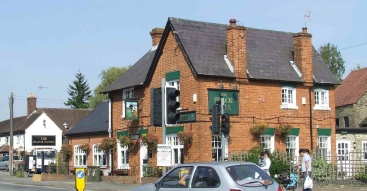
The Black Bull on Banbury Road, Kidlington. The white building behind is the Black Horse.
Photographs 21 September 2008 by E L McMullin
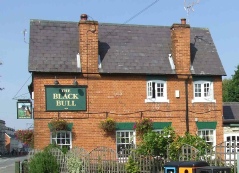
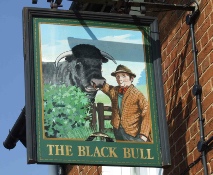
More Oxfordshire Pubs
James Walter GILES [11718] was the Innkeeper of this pub in 1901. He was born 1874 in Woodstock a descendant of Martin GILES and Mary nee FAULKNER through Thomas (born 1774) and married Mary COGGINS [11786] in 1897 when he used the name Walter J GILES. The pub is in an area famous for blanket weaving so the name probably reflects the sheep shearers of the district.
In 1891 the Britannia Inn was kept by James [11850] and Ann COGGINS. Their daughter Mary [11786] married James Walter GILES [11718] who kept the Hand and Shears. (see above)
The Britannia is situated near the Oxford Canal and has change its name to the Jolly Boatman. As yet no connection has been found between this James COGGINS who was from Bicester Market End and the COGGINS of Lower Heyford.
Between 1754 and 1765 William TAUNT [10404] is listed in the Victuallers Recognizances (QSD/1 1753-1772) but the inns are not named. In ‘The History of Banbury Road Kidlington’ by John Amor of the Kidlington History Society, William Taunt is mentioned as the Inn keeper of The Black Bull and was said to have left the Black Bull in 1766 and died in1797. It is thought the original Black Bull was on the opposite side of Banbury Road as although the Black Bull and Black Horse are now next to each other, a map of the enclosures shows three plots between the pubs one with three cottages, one with a cottage belonging to an Ale House keeper Samuel TOLLEY and the third plot being a garden of 3 poles.
The Black Horse, Banbury Road, Kidlington.
The Black horse was once three cottages dating back to 1692 (History of Banbury Road Kidlington John Amor) and first mentioned as the Black horse in 1753.
Peter SODEN [10797] was a blacksmith and publican at the Blackhorse in 1871. Sadly his young wife died in 1872 leaving a young son. About the same time the following advertisment appeared in Jackson’s Oxford Journal for April 20 1872
"KidlingtonThe useful household furniture, stock in trade, useful billiard table etc. etc., of Mr Peter Soden, blacksmith, under distress for rent, at the Black Horse Inn,
To be sold by Auction by J & W Scroggs,
On Monday April 20th at Twelve o'clock"
To be sold by Auction by J & W Scroggs,
On Monday April 20th at Twelve o'clock"
Nothing else has been found of Peter after this. His son went first to live with Peter’s sister and brother in law George and Sarah WAGSTAFF and was eventually adopted by them. George WAGSTAFF [10800] had been the innkeeper of The Flying Horse Brackley in 1861
Peter’s cousin Joseph HONOR [12593] took over the Black Horse. Joseph continued working as a painter, plumber and glazier while at the pub. Joseph died in 1888 and his wife Sarah [12625] was the publican in 1891. She left about 1894 and died in Woodstock District in1901.
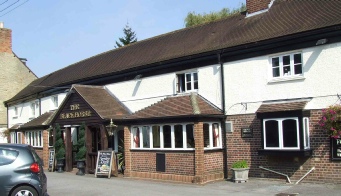
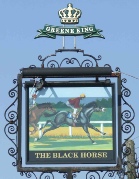
Photographs taken by E.L.McMullin
21 September 2008
Coggins Family of Lower Heyford.
Two pubs in Lower Heyford have been connected to the COGGINS family, the Red Lion and the White Horse.
According to British History online there were three houses in Lower Heyford were licensed as Ale Houses in 1735. The Red Lion is thought to have been one. It was certainly known by that name in 1784 when the names were given in the Victualler Recognizances kept in Oxford Record Office. The other Lower Hayford pub named was The Bell. In 1789 The Red Lion was being kept by a George COGGINS (no known family connection). This was the only reference to George COGGINS keeping the pub. A John COGGINS [12740] was then listed at the Red Lion between 1791 and 1822 when the of the fourth volume of Victualler Recognizances QSD/V4 end. The book lists the people who stood suretee to the innkeeper, often innkeepers stood for others in their area so in 1818, for example, Robert ABRAHAMS of the Three Horseshoes Upper Heyford stood for John COGGINS and John stood for Robert. Interestingly one of the people standing surettee for John in 1820 was Benjamin COGGINS.
Benjamin is most likely to be the son of John baptised in Lower Heyford February 17th 1796. On the censuses for 1841 and 1851 Benjamin COGGINS [12739] was the Victualler at the Red Lion.
In the History, Gazetteer & Directory of Oxfordshire 1852 Robert Gardner lists Benjamin COGGINS at the Red Lion. As yet we have not been able to connect John and Benjamin to our tree.
The first mention of a connected COGGINS at the Red Lion was in the The Post Office Directory for Oxfordshire 1854 which mysteriously has entries for Coggins Richard White Horse and Coggins Richard Red Lion. As Richard [11891] is in the White horse in 1841 and 1851 he was probably moving from the White Horse to the Red Lion when the data was being collected.
In 1861 Lewis COGGINS [12365] age 19 was a Victualler Coal & Timber Dealer with 10 acres and employing 4 men at the Red Lion and his sister Louisa [12367] was the housekeeper. Their father Richard [11891] and stepmother are on a farm in Upper Heyford. The Dutton, Allen & Co’s Directory & Gazetteer of the Counties of Oxon, Bucks... for 1863 lists in Lower Heyford “Coggins, Richard, Red Lion, coal and corn merchant,and farmer”. In this publication publicans and innkeepers appear to be indicated simply by their address. The people listed at “The White Horse” and “The Bell” and the “Horse and Groom” are not mentioned as publicans In the same publication Richard COGGINS [11891] is listed as a farmer and grazier, in Upper Heyford. (Only one Richard COGGINS appears on the 1861 census for Upper and Lower HEYFORD)
In The Oxford Chronicle for 10 September 1864 there was a report about the Heyford Village Harvest Home “The dinner was provided by Mr T TURBITT of the RED LION, and Mr W SMITH of the BELL, and included substantial dishes of roast and boiled beef and mutton, rich plum puddings, etc. And was served in a manner which reflected the greatest credit upon the respective hosts”. At the Harvest Home 150 men and women sat down for the dinner. Diarist George James DEW also gives an account of the event in his entry for Sept 7.
Thomas Hewin TURBITT [12038] married Louisa Julia COGGINS in 1863 and it appears that he took over the pub. He died and was buried on Dec 24 1869. Dew wrote ‘His end is another illustration of the dangers & sad effects of drinking.’
In 1871 the widowed Louisa was still the Housekeeper at the Red Lion. George COGGINS [11906] a cousin of Richard was at the White Horse. The Harrod’s Directory of 1876 has Richard COGGINS as Coal merchant and Inn keeper indicating that Richard was probably the licensee while his daughter was keeping the pub. Richard had a large farm in Upper Heyford for several censuses.and unlikely to have kept the premises himself.
George COGGINS [11906] son of George [11877] the Parish Clerk of Middleton Stoney was listed in Dutton, Allen & Co’s directory & gazetteer of the counties of Oxon, Bucks... for 1863 as a “baker and mealman”. He was involved with a married woman in 1867 and Dew wrote in his diary about the way the villagers made their disapproval known by treating him to “Rough Music”. At that time he was described as a “Drunkard” so it was surprising to find that in 1881 he was the landlord of the Red Lion. In 1881 he is not mentioned as a publican but was a Corn & coal merchant’s clerk but his house wzs next to Ivy House as was the Red Lion is in 1891. The applications for licences in the quarter sessions need to be found to see if he was in fact also the landlord in 1881. Dew’s diaries show how the people of the area held more than one job at a time for example his own father was a builder, carpenter, timber merchant, grocer, baker and post master and they entered what they considered their principle occupation on the census returns.
The pub featured largely in community life in the late 1870s Entries in Dew’s diary for the pub include meetings of the Deddington, Heyford & Aston Benefit Building Society on Jan 8 1872, March 19 1873 and Oct 1873 when George Coggins was elected secretary on that ocasion he was mentioned as “Clerk to C. Duffell Faulkner (solicitor to the Society)” The diary entry for May 9 1872 describes a meeting held in front of The Red Lion inviting farm labourers to join a union.
Little is known about The White Horse, it was not mentioned in the early Victualler Recognizances book and it had closed by 1887. Richard COGGINS [11891] from Caulcott was a victualler and Coal merchant there in 1851.
The History, Gazetteer & Directory of Oxfordshire 1852 by Robert Gardner has “Coggins Richard, (and corn and coal merchant , wharfinger &c.)” under Farmers of Lower Heyford. In the description of Lower Heyford Gardner says “...The railway company have a station here, and there is an excellent wharf on the canal, belonging to Mr Richard Coggins, so that the town affords abundant facilities for the transit of passengers, and agricultural produce...” (there is no mention of either pubs.)
Then the Post Office Directory for Oxfordshire 1854 has Richard in both the White Horse and Red Lion. Did Richard own both pubs or was he between pubs taking the Red Lion over after Benjamin COGGINS? More research is required.
A James HEYWARD a carrier was at the listed in the Dutton Allen & Co’s Directory & Gazetteer of the Counties of Oxon, Bucks 1863. The History, Gazetteer & Directory of Oxfordshire 1852 by Robert Gardner has “Coggins Richard, (and corn and coal merchant , wharfinger &c.)” under Farmers of Lower Heyford. The description of Lower Heyford says “...The railway company have a station here, and there is an excellent wharf on the canal, belonging to Mr Richard Coggins, so that the town affords abundant facilities for the transit of passengers, and agricultural produce...” but there is no mention of either pub.
Then the Post Office Directory for Oxfordshire 1854 has Richard in both the White Horse and Red Lion. Did Richard own both pubs or was he between pubs taking the Red Lion over after Benjamin COGGINS? More research is required.
In 1861 John Hayward a carrier was the publican at the White Horse. He died Jan 24 1865. His death is mentioned in Dew’s Diary where he indicates that the White Horse had a bad reputation.
The only Inn at Duns Tew is the 17 century coaching inn ‘The White Horse’ which is still open and has retained its flag stone floors and low beams. This was possibly the one kept by John CANNING [9669] in 1855.when he appears as an Inn keeper on his son’s marriage certificate but the Post Office Directory for 1854 has him as a shop keeper and Mrs Margaret Nichols at the White Horse.
The Dun Cow, Northmoor.
Ellen SMITH [1702] was here in 1881 as innkeeper’s wife although her husband Thomas FROUD [1677] was at the Crispin in Harwell with their oldest son. (The four younger children all who had been born in Childrey between 1872-1880, were with Ellen.) As a daughter was born in 1882 in Harwell it would appear that the family was moving between pubs in 1881.
The Dun Cow is mentioned at www.british-history.ac.uk where it is thought to have been licensed in 1677 and operated under the name from 1793. It was a one storey house and never provided accommodation Sadly it closed and was converted to a private house in 1991. There is a good description of an obviously well liked pub on this website “. ..However the most sadly missed pub in that part of Oxfordshire is the Dun Cow in Northmoor. It had no bar, just two living rooms, the beer was kept racked in the kitchen and served straight from the barrel. ...”
References:
Extracts from Dew’s diaries are in Oxfordshire Country Life in the 1860s. The Early Diaries of George James Dew (1846-1928) of Lower Heyford and Oxfordshire Country Life: The Diaries of George James Dew (1846-1928), Relieving Officer both edited by Pamela Horn
Site layout and content © 2007-